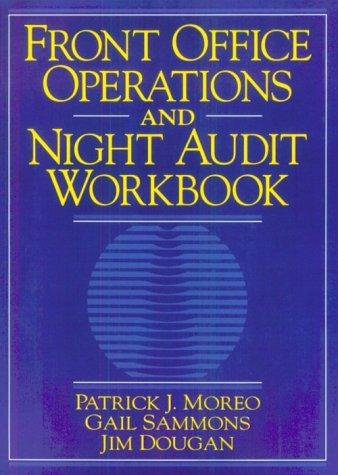Question
A hospital has five service departments and five clinical departments and five outputs DRG1, DRG2, DRG3, DRG4 and DRG5. The costs of the service department
A hospital has five service departments and five clinical departments and five outputs DRG1, DRG2, DRG3, DRG4 and DRG5. The costs of the service department must first be passed onto the clinical departments. Then the costs of the clinical department must be allocated to DRG categories to determine the per-unit cost of each DRG. Budgeted patient numbers for 2010 for each DRG category is:
DRG1 2,200
DRG2 1,200
DRG3 300
DRG4 350
DRG5 550
Budgeted costs for the service departments are:
Administration $300,000
Cleaning $410,000
Security $120,000
Medical records $400,000
Laundry $750,000
The direct costs of the clinical departments are:
Radiology $1,400,000
Laboratory $1,000,000
Physiotherapy $140,000
Nursing $2,400,000
Oncology $2,000,000
Administration costs are to be allocated on the basis of staff numbers.
Cleaning costs are to be allocated on the basis of area occupied.
Security is to be allocated equally among the clinical departments.
Medical records are to be allocated according to patient episodes of care.
Laundry is to be allocated on the basis of kilos of laundry handled.
| staff numbers | area occupied | episodes of care | kilos of laundary | |
| radiology | 30 | 220 sq. ft | 3000 | 115 |
| laboratory | 40 | 270 sq. ft | 4000 | 265 |
| physiotherapy | 20 | 95 sq. ft | 4800 | 165 |
| nursing | 90 | 370 sq. ft | 9800 | 695 |
| oncology | 30 | 210 sq. ft | 4100 | 155 |
The costs of the clinical departments are to be allocated to DRG categories on the basis of service weights only. The service weights are as follows:
| DRG1 | DRG2 | DRG3 | DRG4 | DRG5 | TOTAL | |
| Radiology | 2 | 2.5 | 4.5 | 1 | 0 | 10 |
| Laboratory | 0.5 | 3.5 | 4 | 1 | 1 | 10 |
| Physiotherapy | 2 | 3 | 1 | 1 | 3 | 10 |
| Nursing | 3 | 0 | 2 | 4 | 1 | 10 |
| Oncology | 2.5 | 0.5 | 2 | 3 | 2 | 10 |
Required:
a. Given the above information, calculate the unit costs of each DRG.
b. The government pays the following reimbursements for these DRG categories:
DRG1 $1,000
DRG2 $1,200
DRG3 $7,000
DRG4 $6,000
DRG5 $3,500
Given that this hospital is funded on a casemix basis, explain how the government would calculate these reimbursement rates.
c. Given the hospitals cost structure and these reimbursement rates, what actions should this hospital take with regard to the provision of these DRG services.
d. Suppose that instead of casemix funding the hospital was simply reimbursed for its actual costs in providing the above DRG services. For example, if the hospital incurred costs of $1,500 to provide DRG1 it was reimbursed $1,500 for each DRG1 patient. How would this payment system affect the way in which the hospital provided these services i.e. would the hospitals reaction be different to the way it would have acted in your answer to part 3?
Hint for a) divide total cost by number of patients to get per unit cost
Hint for b) discuss how government (Independant Hospital Pricing Authority or IHPA) decides these rates for each DRG. You have to explain in lay mans term to demonstrate your understanding of Activity Based Funding (ABF), Costing process underlying ABF etc.
Hint : Service weights reflects the resource use of each service for each Diagnosis Related Group (DRG) treatment. For eg., for radiology DRG5 has zero service weight that means no radiology costs are assigned to DRG5. These service weights can be used to determine "allocation rate" that is subsequently used to allocate costs. These service weights are not related to patient numbers but merely reflect resource use. National Weighted Activity Units(NWAU) are a form of service or activity weights that reflect resouce use. A DRG with higher NWAUs will require higher resources and thus is reimbursed higher amount under ABF.
Step by Step Solution
There are 3 Steps involved in it
Step: 1

Get Instant Access to Expert-Tailored Solutions
See step-by-step solutions with expert insights and AI powered tools for academic success
Step: 2

Step: 3

Ace Your Homework with AI
Get the answers you need in no time with our AI-driven, step-by-step assistance
Get Started


